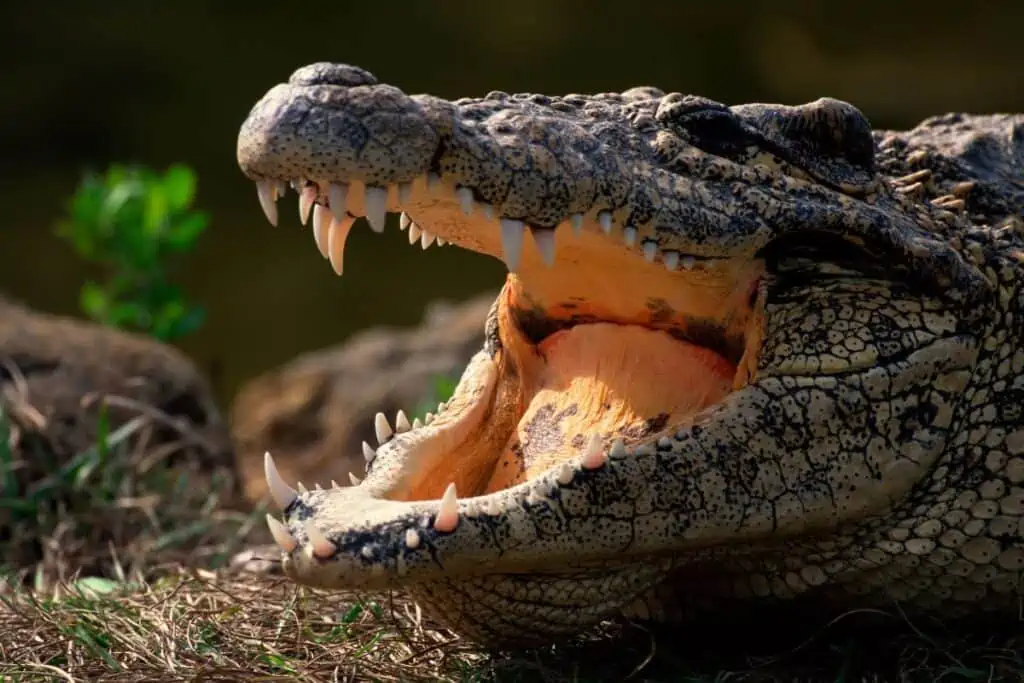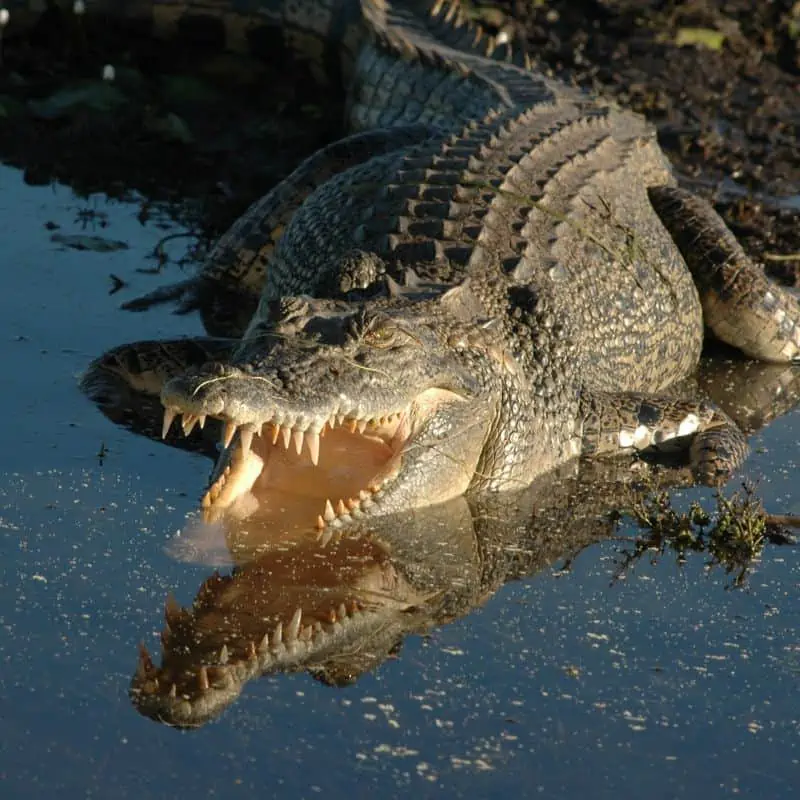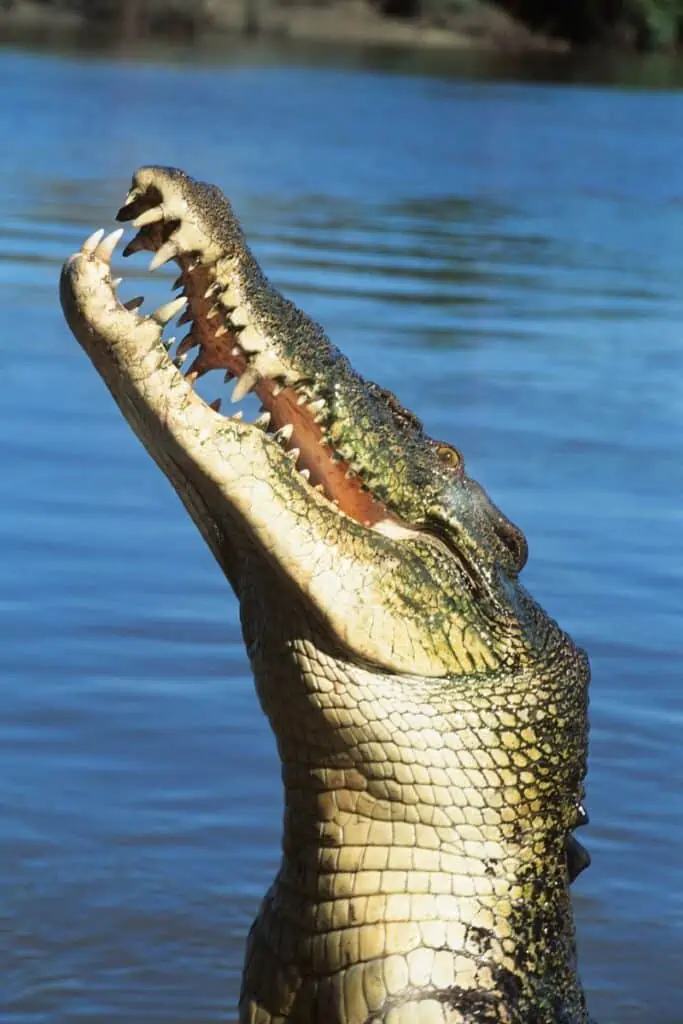“And what big teeth and a strong bite you have,” said the little naturalist, “all the better to crush bones and tear flesh with,” replied the crocodile. The animal kingdom is full of impressive teeth, jaws, and bites for hunting, eating, and defense.
Crocodiles are large, powerful reptiles, but just how strong is a crocodile’s bite force?
Crocodiles have the strongest bite of all land-based animals, and the Saltwater crocodile is at the top spot with a bite of roughly 16,460 newtons, or 3,700 psi. For comparison, humans have a bite force of around 700 newtons, roughly 150 psi.
The disparity between crocodiles’ and other animals’ bite forces is huge. But why do crocodiles need such powerful bites? What are the mechanisms behind this power? And what other variables influence bite force in crocodiles?

- Why Do Crocodiles Have Such An Immense Bite Force?
- Do All Crocodiles Have Such Powerful Bites?
- Factors That Contribute To A Crocodile’s Bite Force
- What Are The Mechanisms Behind A Crocodile’s Bite Force?
- Do Crocodiles Have The Strongest Bite Of All Animals?
- Do Crocodiles Have The Most Powerful Bite Today?
- Discrepancies In The Research
- Final Thoughts On The Crocodiles Bite Force
Why Do Crocodiles Have Such An Immense Bite Force?
We know that crocodiles have an impressive bite of roughly 3,700 psi. But what do they do with their mouths that require so much power?
Especially when it takes roughly “only” 4,000 newtons (N) to break a femur (the strongest human bone)?
Crocodiles Use Their Powerful Jaws And Teeth For Everything
Crocodiles and other crocodilians are carnivores, which (aside from the obvious meat-eating tendencies) means they need to catch their food.
While crocodiles are nimble in the water, they generally ambush their prey. Crocodilians target various prey types.
Most of their prey prefers not to be eaten and puts up a fight, which means that crocodiles need to pull strong, unhappy animals into the water and drown them without losing their “grip.”
Without a powerful bite, crocodiles could not catch larger prey items (as these animals could pull free from a crocodile’s “grasp”) or prey with strong defenses (like turtles) because the crocodile would not be able to overpower the defense (e.g., crack the shell).
Aside from a severe lack of useful arms for feeding (i.e., they need to use their mouths to catch food, kill it and eat it without claws or hands to hold them steady), crocodiles cannot chew their food, so they need to tear off chunks and break bones with their mouths/teeth.
Additionally, crocodiles use their powerful jaws for defense against other crocodiles and would-be predators.
While swimming away is the first line of defense, sometimes a crocodile needs to take a stand and does so with its teeth.

Since Their Origin, Crocodiles Have Needed A Powerful Bite
Crocodiles appeared around the same time as the first dinosaurs, roughly 200 million years ago in the Late Triassic/early Jurassic period.
They swiftly became top predators in a world dominated by “terrifying lizards,” so evolving powerful jaws, strong teeth, and keen hunting strategies were imperative.
If their bites were inferior, their hunting would have been less successful, and we’d probably see a different species in the crocodilian world today.
Do All Crocodiles Have Such Powerful Bites?
While the Saltwater crocodile is at the top of the bite force list with 3,700 psi, other crocodile species vary in their bite forces.
Although not a “true” crocodile (not part of the Crocodylidae family, but part of the same order, Crocodylia), Cuvier’s dwarf caiman (Paleosuchus palpebrosus) has the weakest bite force of the crocodilians, with around 667N.
Factors That Contribute To A Crocodile’s Bite Force
Not all crocodilians are made equal in their ability to bite, but what are some of the variables that influence the strength of a crocodile’s bite?
A Crocodiles Size Dictates Their Bite Force
While comparing each of the 23 crocodilian species’ bite forces, researchers discovered that body size is directly proportional to bite force. I.e., the bigger the body, the stronger the bite force.
The record-setting 3,700 psi bite came from a 17-foot Saltwater “monster.”
The Crocodiles Health, Age, And Physical Condition
Aside from their body size, the crocodile’s health/condition plays a prominent role in bite force.
Injured, sick, juvenile, and old crocodiles have weaker bite forces compared to healthy adults.
The Type Of Food A Crocodile Eats
The crocodile’s food plays a part in the bite force required. For example, the Cuvier’s dwarf caiman eats small fish, amphibians, and invertebrates.
These prey items are not particularly strong and are easily overpowered by the diminutive caiman.
On the other hand, the Saltwater crocodile eats prey as large as water buffalo and cattle (livestock).
Whatever it overpowers, it eats, but its bite needs to be strong enough to prevent the animal from escaping while killing it.
What Are The Mechanisms Behind A Crocodile’s Bite Force?
A prominent feature of the crocodilian jaw is the additional joint (similar to the temporomandibular joint in mammals).
This joint allows the crocodile to distribute the force of the bite evenly across its mouth, preventing the jaw from slipping and twisting.
Aside from this handy joint that assists the crocodile in gripping its prey, they have powerful muscles in their heads and necks, which function in snapping the jaws shut.
The muscle primarily responsible for this closing power is the ventral pterygoideus muscle. As much as 70% of the bite force comes from this muscle.
According to professor Erickson from Florida State University, these muscles evolved and stretched into the crocodile’s neck.
So, what may look like a fat, flabby neck is powerful muscles designed for crunching down on prey.
These powerful muscles work cooperatively with well-developed jaw bones that translate the muscle’s action into biting force.
The crocodile’s (and all crocodilians’) head is a product of millions of years of refining through natural selection, allowing it to deliver impressive bites on unsuspecting prey today.

Do Crocodiles Have The Strongest Bite Of All Animals?
According to National Geographic, a Saltwater crocodile’s bite force might be comparable to that of the Tyrannosaurus rex.
However, these estimates are based on bite projections for specimens of 20 feet and larger.
Scientists estimate that a 20-feet crocodile’s bite force is around 7,700 psi. They estimate that the T. rex had a bite force of around 12,814 psi (57 000N).
However, the crocodile’s predecessor, the Deinocuchus (meaning “terrible crocodile”), probably bit down at a harrowing 23,100 psi (102 750N).
Do Crocodiles Have The Most Powerful Bite Today?
Although saltwater crocodiles have the strongest bite of any living animal measured to date, many animal bites have not been (and probably won’t be) measured. Among these are sharks and orcas.
Computer modeling of a 21-foot Great White shark estimated the shark’s bite force to be around 4,000 psi (or 17 790N).
However, this is speculation, as measuring the bite force of a shark is beyond the capabilities of modern techniques.
So, while Saltwater crocodiles are the current champion chompers, there are presumably other animals with stronger bites.
Discrepancies In The Research
Although scientists try by all means to produce accurate results, when dealing with living creatures (animals), it is often difficult to obtain a 100% unbiased reading.
Depending on the day, a certain animal may not feel up to biting at its full capacity, which could misconstrue the results.
While the data points to the likelihood of crocodiles having the strongest bite, the facts may change as technology improves.
Final Thoughts On The Crocodiles Bite Force
Saltwater crocodiles’ bite forces are the strongest of all recorded animals.
Due to the complex design of their head and neck anatomy, Saltwater crocodiles have a bite force of around 3,700 psi.
Without this incredible biting power, crocodiles would not have survived the dinosaurs, nor would they survive today.

